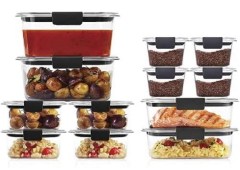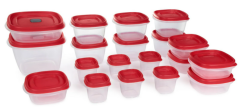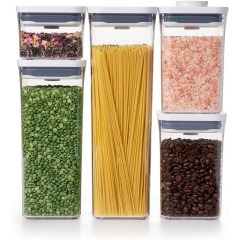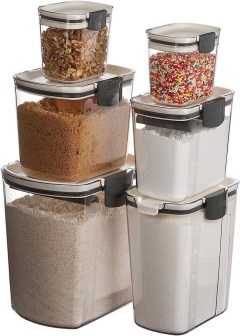BestReviews is reader-supported and may earn an affiliate commission. Details

These containers earn our cooking expert's praise for standing up to long-term use.
Durable containers that are made of BPA-free plastic that's almost as clear as glass so you can easily see contents. Lids have reliable airtight latches for leak-resistant seals.
May absorb some food odors. Full-power microwaving may cause the containers to warp.

Our expert recommends this sizable set for families who pack their lunches often.
In addition to being affordable, these containers snap together for easy storage. Collection includes 19 containers in versatile sizes with lids that close tightly to keep foods fresh. BPA-free.
Can warp in the microwave. Not all of the lids have vents. Some of the containers are quite small.

A smart choice that our expert likes for being uniquely oven- and microwave-safe.
Stands out for versatility, as these glass containers can be used for storage and food prep in the microwave or oven. Airtight lids provide mess-free storage. Recyclable, and doesn't contain BPA.
Breakable, so must be handled with extra care. Heavier than plastic containers and bulky to store.

We found that these airtight containers come in a good variety of sizes, making them perfect for the pantry.
We really liked how the plastic is both thick and durable making them perfect for homes with families. The containers can be stacked on top of one another. The pop button makes sealing the containers a breeze.
The seal isn’t watertight, so using it for liquids is not recommended.

The perfect size and an airtight seal that keeps food fresh make this an excellent choice that is backed up by our staff.
Has a wide top so getting food in and out of the container is fairly easy. Can stack on top of each other for easy pantry storage. Some containers come equipped with easy-pour spouts designed for baking. We love how well the air-tight seal works.
The leveling bar for the flour container can sometimes cause spillage.

After going through an intensive research process to narrow down our short list of top products in this space, we tested the OXO Good Grips container set to be sure that it’s worthy of our recommendation. Guided by experts, we spend hours looking into the factors that matter and test to verify manufacturer claims.

After you've spent time preparing a delicious meal, you want the leftovers to stay just as fresh and tasty as the day you cooked the food. Good food storage containers are essential to ensure that food tastes just as good on the second or third day. The airtight quality of the best containers preserves fresh foods in the fridge and prevents dry foods from getting damp or infested with weevils or other pests.
But with hundreds — if not thousands — of food storage containers on the market, how do you find the right type for you? We've gathered some key details that will help you make the right choice.

Should you buy food storage containers that are plastic or glass? Would you appreciate containers with locking lids? Below, we investigate the options.
Basic plastic food storage containers come with snap-on lids and can hold a range of wet and dry foods.
Pros of plastic food storage containers:
Plastic containers are very affordable.
They generally come in a wide range of shapes and sizes.
These containers are durable and unlikely to break or chip.
Plastic is usually microwave safe.
Cons of plastic food storage containers:
Plastic snap-on lids can leak if turned upside down or on their side.
Plastic can be stained by strong odors and colorful food.
Not all plastic containers are BPA-free.
This type of food storage container is made from sturdy glass — Pyrex, for example — with a plastic snap-on lid.
Pros of glass food storage containers:
The main body will always be BPA-free, though you'll have to check product specs regarding the plastic lid.
Glass food storage containers can be placed in the oven (without the lid) to reheat food.
Glass containers are heavy-duty and long-lasting — as long as you're gentle with them.
Cons of glass food storage containers:
Glass can smash or chip if dropped.
These containers are generally quite heavy. If you want to take food on the go, the extra weight could be a problem.
These may be made of glass or plastic, but regardless of their material, they have special lids with double seals and tabs that lock at four points around the edge of the container.
Pros of locking food storage containers:
The locking design helps prevent leaks, even when the container is turned on its side. As such, this type of container is ideal for lunch on the go.
Locking containers can generally be found in plenty of sizes, both round and square.
Cons of locking food storage containers:
These containers usually cost a bit more than food storage containers with snap-on lids.
If you want to store dry goods, such as pasta or lentils, look for containers marketed specifically for the storage of dry foods.
Pros of dry food storage containers:
Dry food containers can help you keep your dry goods fresh. This includes pasta, beans, cereal, and more.
These containers come in a range of shapes and sizes, including upright varieties.
Certain models have "doors" in the lids to easily pour out food, like breakfast cereal.
Cons of dry food storage containers:
Dry food containers aren’t leak-proof, but this shouldn't matter if you only want to store dry goods.
Not all of these containers are BPA-free.




















It's wise to own food storage containers in a range of sizes. Why? Our expert, Jessica, explains: "Having a variety of sizes helps make storing food and packing meals so much easier."
For example, if you only have large food storage containers, saving a couple tablespoons of salad dressing in a two-quart container is hardly space-efficient. In that same vein, you can’t conveniently store a pot of stew you made for the week if you only have single-portion food containers.

Should you buy containers that are round, square, or another shape? We offer these pointers.
Select round or oval food storage containers for storing sauces and anything that needs to be stirred before use. It's hard to properly stir food in a container that has corners.
Unless you need to stir your food, choose square or rectangular containers to maximize storage space.
Choose upright containers for dry goods that you plan to store on a shelf or in a cupboard. They consume less surface area and line up neatly, so you can easily see what's inside each container.
Easy-stack food storage containers have special ridges around the edge of the lid.
When you place one stackable storage container on top of another, it lines up neatly and won't slide around or topple the stack.
These tips will turn you into a food storage pro before you know it.
When storing empty food storage containers, nest smaller ones inside larger ones. Stack the lids separately to save space.
Even when food storage containers claim to be dishwasher safe, they sometimes don't seal as well after a number of hot cycles through the dishwasher. For best results, wash your food storage containers by hand.
Avoid using a container that’s larger than you need, as the air trapped with your food can cause it to go bad faster.
Quickly rinse plastic food storage containers right after emptying them to help prevent stubborn stains and smells.
Prep and store vegetables in advance to make weeknight meals faster. Chopped, raw veggies should last for four to five days in an airtight food storage container.

The price you pay for food storage containers depends on a number of factors, including size, material, and whether you're buying a set or individual containers.
Inexpensive food storage containers are generally made of plastic with snap-on lids.
The cheapest out there may be fairly flimsy, so beware. Expect to spend $0.25 to $1 per container.
Mid-range food storage containers include most plastic locking containers and larger plastic dry food containers, such as those designed for breakfast cereal.
Expect to spend $1 to $4 per container.
Expensive dry food containers include those made of glass and rigid plastic. These are designed to last many years.
Expect to pay $4 to $8 per container.

A. Certain foods, such as tomato-heavy dishes or curries containing turmeric, can stain plastic food storage containers. Try spraying a little cooking spray into the container before adding items that might stain. Or, simply use glass containers for the offending foods.
Our expert, Jessica, says: "Foods seasoned with turmeric and other brightly colored ingredients (like beets, for example) may stain many plastic containers when reheated in them. It may be better to reheat those foods in glass containers."
A. Even food storage containers that are labeled "microwave safe" are likely to degrade quicker if they're regularly nuked in the microwave. Transfer the contents to a microwavable plate or bowl when possible. That said, it is handy to have microwave-safe food storage containers, just in case.
Get emails you’ll love.
Learn about the products you’re wondering if you should buy and get advice on using your latest purchases.
